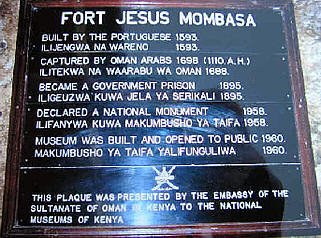Fort Jesus is a fort located on Mombasa Island in Kenya. Designed by the Italian architect Giovanni Battista Cairati and built by the Portuguese. It was built between 1593 and 1596 by order of King Felipe II of Spain, who also reigned as King Filipe I of Portugal and the Algarves, to guard the Old Port of Mombasa. Fort Jesus is the only fort maintained by the Portuguese on the Swahili coast and is recognized as a testament to the first successful attempt by a Western power to establish influence over the Indian Ocean trade.

Fort Jesus in Mombasa is a historical Portuguese fortress, a UNESCO World Heritage Site, and one of the best examples of 16th-century Portuguese military architecture. Built in 1593-1596, it was designed to protect the port of Mombasa and was a significant part of Portugal’s efforts to control trade routes to the east. The fort was built to secure the safety of Portuguese residents on the East Coast and to protect trade routes from Arab and African incursions.
It witnessed the struggles for control of the strategic port of Mombasa between Portuguese, Arab, and other powers, showcasing cultural exchange and conflict.
Cairati, inspired by Italian architect Pietro Cataneo, designed the fort, with the master builder being Gaspar Rodrigues. This was Cairato’s last overseas work. Although the design of Fort Jesus is an example of Renaissance architecture, the masonry techniques, building materials, and labor are believed to have been provided by the local Swahili people. The fort, built in the shape of a man viewed from the air, is roughly square with four bulwarks at its corners and is considered a masterpiece of late Renaissance military fortification.

Fort Jesus was captured and recaptured at least nine times between 1631, when the Portuguese lost it to Sultan Yusuf ibn al-Hasan of Mombasa, and 1895, when it fell under British rule and was converted into a prison. After the Portuguese recaptured it from the Sultan in 1632, they refurbished it and built more fortifications, subsequently making it harder for the fort to fall. The fort was subject to an epic two-year siege from 1696 to 1698 by the Omani Arabs, led by Saif bin Sultan. The capture of the fort marked the end of Portuguese presence on the coast, although they briefly captured and re-occupied it between 1728 and 1729 with the help of the Swahili city-states. The fort fell under local rule from 1741 to 1837, when it was again captured by the Omanis and used as a barracks, before its occupation by the British in 1895, after the establishment of the East Africa Protectorate (which later became, in 1920, the Colony and Protectorate of Kenya).
Between 1631 and 1875, the fort was won and lost nine times by the nations contesting control of Kenya. The Omanis took the fort in 1698 after a notable siege of almost three years. It was declared a historical monument in 1958. Today it houses a museum.
The fort was designed by a Milanese architect, Giovanni Battista Cairati, who was the Chief Architect for Portuguese possessions in the East. Today, it is one of the finest examples of 16th-century Portuguese military architecture, which has been influenced and changed by both the Omani Arabs and the British.
The fort quickly became a vital possession for anyone with the intention of controlling Mombasa Island or the surrounding areas of trade. When the British colonized Kenya, they used it as a prison, until 1958, when they converted it into a historical monument. James Kirkman was then assigned to excavate the monument, which he did (with a large use of external historical documents) from 1958 to 1971.

The architecture of the fort represents the rough outline of a person lying on their back, with their head towards the sea. The height of the walls is 18 meters. The original Portuguese fort had a height of 15 meters, but the Oman Arabs added 3 meters upon capturing the fort.
The fort combines Portuguese, Arab, and British elements (these being the major powers that held it at different times in history). The Portuguese and British presence is preserved in the presence of their respective cannons. The Portuguese cannons had a range of 200 meters and were longer than the British cannons, which had a range of 300 meters. Oman Arabs marked their occupancy with numerous inscriptions from the Koran on the wooden door posts and ceiling beams. The Muslim tradition of five pillars is also portrayed throughout the fort, with a former meeting hall supported by five stone pillars to the ceiling.
Some of the historical structures still standing in the fort include Oman House, which was the house of the sultan who governed the East African coast. Others are an open water cistern by the Portuguese for harvesting rainwater, and a 76-foot deep well sunk by the Arabs (but its water was too salty to be used for anything but washing).
Today, Fort Jesus is a popular destination for foreign and local tourists and serves as a tourist destination, the fort is important as a host for numerous research programs, a Conservation Lab, an Education Department, and an Old Town Conservation Office.
A little History about Fort Jesus
Fort Jesus, located on the edge of a coral ridge overlooking the entrance to the Old Port of Mombasa, was built by the Portuguese in 1593-1596 to protect their trade route to India and their interests in This is the plaque presented by the Oman embassy in Kenya to the National Museum of Kenya with some historical dates of Fort Jesus, East Africa. This was after the Portuguese had been masters of the East African coast for nearly an hundred years. During this time they had as main base an unfortified factory in Malindi. The Turkish raids of 1585 and 1588 were decisive for the Portuguese to decide the construction of the fort in Mombasa. On 11 April 1593 the fortress was dedicated and named “Fortaleza de Jesus de Mombaça” by Mateus de Mendes de Vasconcelos (the then captain of the coast, that resided at Malindi). The fort was completed in 1596, the plan was a quadrilater with four bastions: S. Felipe, S. Alberto, S. Mathias and S. Mateus. The main gate was near S. Mathias bastion. It was designed by an Italian architect, Giovanni Battista Cairati. Mombasa became Portugal’s main trading centre along the East Coast of Africa.
Relations between the Portuguese and the Sultan of Mombasa (who were the rulers of Mombasa at the time of the fort’s construction) began to deteriorate after the departure of the first captain Mateus de Mendes de Vasconcelos. In 1626, Muhammad Yusif, who had received education in Goa, and baptized as Dom Jeronimo Chingulia, was made Sultan. On 16 August 1631, the Sultan Dom Jeronimo Chingulia entered the fort and took the Portuguese by surprise, he killed the Portuguese captain, Pedro Leitão de Gamboa, and massacred the whole Portuguese population of Mombasa (45 men, 35 women and 70 children). A Portuguese expedition was sent from Goa to retake the fort, but after two months of siege (10 January 1632-19 March 1632) they abandoned the enterprise. On 16 May the Sultan abandoned Mombasa and became a pirate.
In February 1661 the Sultan of Oman sacked the Portuguese town of Mombasa but did not attack the fort. It was in 1696 that a large Omani Arabs expedition reached Mombasa, from 13 March 1696 the fort was under siege, the fort had a garrison of 50-70 Portuguese soldiers and several hundred loyal coast Arabs. The fort was relieved in December 1696 by a Portuguese expedition, but in the following months a plague killed all the Portuguese of the garrison and by 16 June 1697 the defence of the fort was in the hand of Sheikh Daud of Faza with 17 of his family, 8 African men and 50 African women. On 15 September 1697 a Portuguese ship arrived with some reinforcement and also at the end of December 1697 another ship came from Goa with a few soldiers. After another year of siege, in December 1698, the Portuguese garrison was reduced to the Captain, 9 men and a priest (Fr. Manoes de Jesus). After a siege of two years and nine months the Omani Arabs took the fort. They could do this because the garrison was reduced to nine soldiers the others died by disease. On the morning of 13 December 1698 the Omani Arabs did the decisive attack and took the fort, just seven days later a gun was salvaged from the German warship “Königsberg”, used by the Germans during the East African campaign in World War I and later seized by British Empire forces, who took it as a trophy from German East Africa (now Tanzania) to Kenya. It is located next to the entrance gate of Fort Jesus. Portuguese relief fleet arrived at Mombasa, but it was too late. With the conquest of Fort Jesus the whole coast of Kenya and Tanzania with Zanzibar and Pemba fell to the Omani Arabs.
The Portuguese retook the fort in 1728, because the African soldiers in the fort committed mutiny against the Omanis, the Sultan of Pate to whom was offered the fort. He handed the fort over to the Portuguese on 16 March 1728. In April 1729, the Mombasans revolted against the Portuguese and put under siege the garrison that was forced to surrender on 26 November 1729.
The Fort is today know as one of the best examples of 16th century Portuguese military architecture.
Stay tuned to the Global African Times to discover more African Historical sites.




